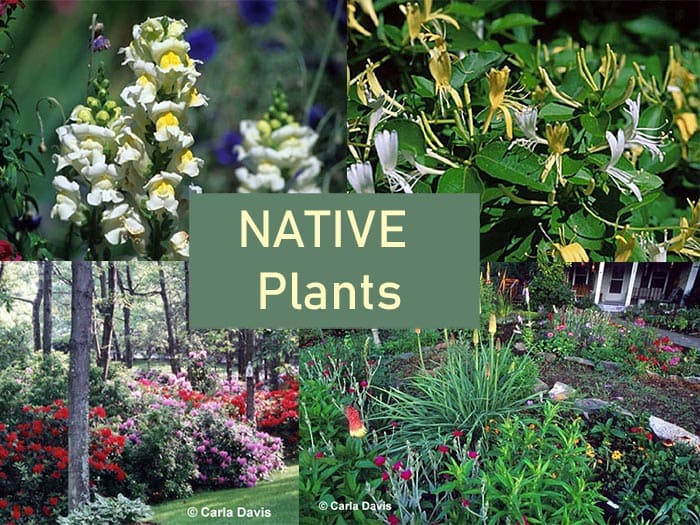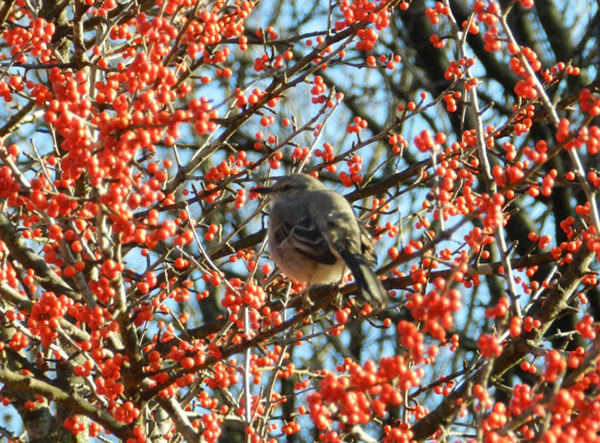
Texas Plants for Wildlife Habitat & Conservation Landscaping
Trees
Box Elder; Pecan; Shagbark, Black and Mockernut Hickory; Hackberry; Redbud; Parsley Hawthorn; Persimmon; White and Green Ash; Possum Haw; Texas, Black, River and Little Walnut; Ashe, red-berry and Rocky Mountain Juniper; Eastern Red Cedar; Sweet Gum; Black Gum; Pinyon, Loblolly and Ponderosa Pine; Quaking Aspen; Chickasaw and Mexican Plum; Black Cherry; Southern Red, Gambel’s, Overcup, Bur, Blackjack, Chinkapin, Willow, Shumard, Post and Live Oak; Carolina Buckthorn
Shrubs
White-ball Acacia; Four-wing Saltbush; Chittamwood; Mountain Mahogany; Rabbit Brush; Rough-leaf Dogwood; Feather Plume; Black Dalea; Winterfat; Swamp Privet; Desert Olive; One-seed Juniper; Winterberry; Yaupon; Sweetspire; Pink Mimosa; Honey Mesquite; Chokecherry; Smooth, Prairie Flameleaf and Desert Sumac; Buffalo Currant; Prairie, Carolina and Illinois Rose; Dwarf Palmetto; Eve’s Necklace; Coralberry; Sparkleberry; Black Haw
Flowers
Sand Verbena; Prairie Dandelion; Prairie Onion; Thimbleweed; Pussytoes; Spreading Dogbane; White Prickly Poppy; Jack-in-the-pulpit; Prairie Sage; Antelope Horns; Swamp and Showy Milkweed; Butterflyweed; Heath and Sky Blue Aster; Milk Vetch; Square-bud Primrose; Indian Paintbrush; Basket Flower; Rocky Mountain Beeplant; Lance-leaved and Plains Coreopsis; Blue and Prairie Larkspur; Purple Coneflower; Engelmann Daisy; Prairie Fleabane; Rattlesnake Master; Joe-pye Weed; Flowering Spurge; Texas Bluebell; Indian Blanket; Bluets; Northern Sweetvetch; Common, Maximilian, Plains and Ox-eye Sunflower; Southern Blue Flag; Gayfeather; Blazing Star; Blue and Yellow Flax; Sand, Red, Fendler and Whorled Penstemon; White and Purple Prairie Clover; Prairie Coneflower; Black-eyed Susan; Prairie Verbena

Mockingbirds can be spotted easily in the area when you go bird watching in Texas.
Vines
Trumpet Creeper; American Bittersweet; Leather Flower; Purple Clematis; Woodbine; Arizona, Riverbank, Muscadine Grape and Canyon Grape; Kentucky Wisteria
Cactus
Tree Cholla; Common Prickly Pear; Yucca
Grasses
Western Wheatgrass; Ticklegrass; Big, Splitbeard, Bushy, Little and Sand Bluestem; Sideoats, Black, Blue and Hairy Grama; Buffalograss; Canada Wild Rye; Plains Love Grass; Tobosa; Junegrass; Bush Muhly; Vine Mesquite; Switchgrass; Indiangrass; Tall and Sand Dropseed; Eastern Gamagrass
In the south, the Gulf Coast Plain meets the Gulf of Mexico. The North Central Plains slope upward creating some hills. The Great Plains extend to the Panhandle where they are broken by low mountains, a southern extension of the Rocky Mountains called Trans-Pecos.The Native Plant Society of Texas can provide lists of plants for a specific region.
For more information on improving your wildlife habitat, visit the WindStar Wildlife Institute web site. On the web site, you can also apply to certify your property as a wildlife habitat, register for the “Certified Wildlife Habitat Naturalist e-Learning course, become a member and sign up for the FREE WindStar Wildlife Garden Weekly e-mail newsletter.

